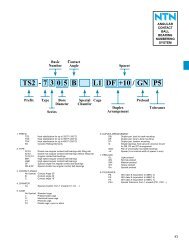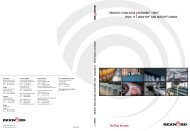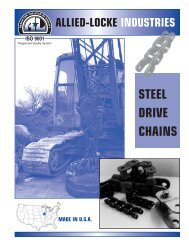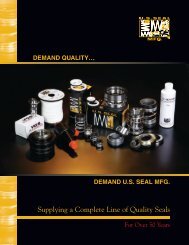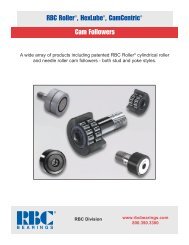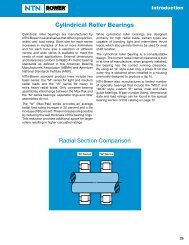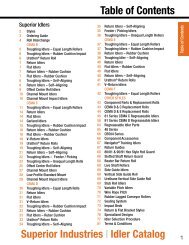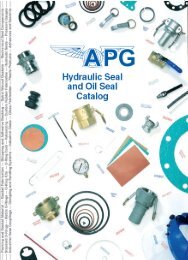<strong>Chain</strong> rolling or sliding and material carriedLayout BDRIVEP CVVertical elevator with material carriedLayout CP ELDRIVETRAVELLTRACKRTAKE-UPTRACKYFig. 5069TRAVELRThe total conveyor pull (P CV) is the sum of the following:Pull on loaded run:to move load = (W + M)YF PL = (W + M)YF + (W + M)Rto lift load = (W + M)RPull on return run NP R= WYFTake-up pull ∆P TUor P CPull to operate tail sprocket P R× .1Pull from other factors P OCalculate the total chain pull per strand (P T) by dividing P CVbythe number of strands taking the load.RM Disregard when is greater than factor F.Y∆ Usually, the takeup pull is known. If not, use 0.3% of the chain’s ultimatestrength as a reasonable estimate.Horsepower required to operate the conveyorHP = (P CV- P TUor P C) × 1.2 × S33,000TAKE-UPFig. 5073The total elevator pull (P EL) is the sum of the following:Pull on loaded runP L= (W + M)RTake-up pullP TUDigging pullP B= M × sPull to operate tail sprocket P TU× .1Calculate the total chain pull per strand (P T) by dividing P ELbythe number of chain strands used in the elevator.∆ Usually, the takeup pull is known. If not, use 0.3% of the chain’s ultimatestrength as a reasonable estimate.s For material with small lumps, multiply M by the sprocket diameter. For fine orfluffy materials, multiply M by the sprocket radius.Horsepower required to operate the elevatorHP = P EL– (P TU+ WR) × 1.2 × S33,000E77E-7
Conveyor EngineeringESelection ExampleThis example illustrates the method of selecting a conveyorchain solely on the basis of ultimate chain strength. Attachmentspacing, appearance, or other factors may make it desirable touse a larger, higher strength chain than the minimum indicatedby the conveyor pull formula and working factor.ProblemSelect a conveyor chain for the following application:Type of conveyor . . . . . . . . .Double-strand horizontal slatconveyor, evenly loaded, withchain rolling and materialcarried. <strong>Chain</strong> lubricated andsupported on carrying andreturn runs.Conveyor speed . . . . . . . . . .200 FPMApprox. center distancebetween shafts . . . . . . . . .60 feetApprox. sprocketdiameters . . . . . . . . . . . . .8.250"Sprocket bores . . . . . . . . . . .1.938"Weight of material . . . . . . . .70 pounds per conveyor footKind of material . . . . . . . . . .35 pound cans, 10" diameter,spaced 2" apart, 2 cans perconveyor foot.Weight of slats . . . . . . . . . . .5 pounds per conveyor footSize and spacing of slats . . .Will be designed in relation topitch of chain selected.SolutionSelect the layout • Layout A on page E-6 illustrates ahorizontal conveyor with chain rolling and material carried.Calculate the approximate conveyor pull • As indicated inthe selection procedure, certain assumed values are used in thelayout formula at this point.<strong>Chain</strong> weight = 2 lbs. per foot per strandTake-up tension = 40 lbs. per strandRolling friction factor = .12Using these values, the approximate conveyor pull is the sum ofthe following:Pull on loaded run P L= (W + M)LF= (5 + 4 + 70)60 × .12 =569Pull on return run P R= WLF= 9 × 60 × .12 = 65Takeup pull P TU= 40 x 2 = 80Pull to operate tail sprocket P R× .1 = 65 × .1 = 7Total conveyor pull P CV=721Establish the working factor • The working factor listed onpage E-4 for a chain speed of 200 feet per minute is 14.Determine the minimum conveyor strength required • Theminimum requirement is:721 x 14 = 10,094 poundsDetermine the minimum chain strength required • Sincethis is a double-strand conveyor, with each strand evenly loaded,the minimum chain strength per strand is 10,094 ÷ 2 or 5,047pounds ultimate strength.Select the chain • Since a rolling chain is desired, refer toTable 6 and tentatively select C 2052 chain which has largediameter rollers and an average ultimate strength of 6100poundsCheck the chain selection • From Layout A, <strong>com</strong>pute theactual conveyor pull, using the weight of C 2052 chain shown inTable 6. Since the actual takeup pull is not known, use .3% ofthe ultimate strength of C 2052 chain for each strand. Also usethe rolling friction factor for C 2052 shown in Table 8. The actualconveyor pull is the sum of the following:P L= [5 + (2 x .83) + 70] 60 × .11 = 506#P R= [5 + (2 x .83)] 60 × .11 = 44#P TU= .003 × 2 × 6100 = 37#P R× .1 = 44 × .1 = 4#Total conveyor pull (P CV) = 591#Minimum conveyor strength = 591 × 14 = 8274#Minimum chain strength per strand = 8274÷ 2 = 4137#The selection of C 2052 chain with an ultimate strength of 6100pounds is satisfactory.Determine the number of teeth in the sprockets • Refer tothe listing for 2050 sprockets on page E-12. Note that a 19-toothsprocket has a pitch diameter of 7.595" which is slightly lessthan the appropriate outside diameter of 8.250" desired, andthat they will readily ac<strong>com</strong>modate the 1.938" bore requirement.If a distance of 8.240" between the carrying and return runs issatisfactory, use 19-tooth sprockets.Calculate the chain length and sprocket chains • Since thenumber of teeth in the sprockets are equal, the chain lengthfrom the formula on page E-5 is:19 + 2(60 × 12) = 1171 pitches. Use 1172.1.25Exact sprocket centers, based on 1172 pitches, are:C = 1172 - 19 × 1.25 = 720.625", or 60' .625"2Lubrication • Refer to page E-9 for re<strong>com</strong>mendations.Calculate the horsepower requirement • Use the formulaac<strong>com</strong>panying Layout A to determine the horsepowerrequirement of the conveyor drive.HP = (591 - 37) × 1.2 × 200 = 4.0333,000E-8




